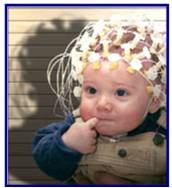
When a child is born, he or she is exposed to quantities from a very early stage in life. Some say that we come into this world with inborn basic abilities to perceive and evaluate quantities. As children grow older, their numerical abilities in most cases improve, and they acquire mastery in many skills such as verbal counting, object counting, understanding the meaning of adding and subtracting, etc. Among the numerical abilities is the understanding and learning of the association between number words, Arabic numerals and quantities.In our research we focus on the course of the development of the associations between quantities and numerals.
Our experiment examines brain development in number processing. By the use of behavioral and brain functioning data, we are able to understand the course of that development. The method that we use to measure brain activity is ERP (event-related electrical potentials)—a method enabling the recording of brain activation: Electroencephalography (EEG). In this method, the electric brain activity is measured by a network of electrodes, which are placed over (covering) the subject’s scalp. When a stimulus is presented, the changes in brain activity are recorded and are later on averaged. This technique enables accumulating reliable data regarding the source of brain activation with both high temporal and spatial resolution.
The importance of this research is in promoting the understanding of the way people acquire the concept of numbers symbols (number words and numerals). The present research aims to contribute the investigation of number processing development, both in terms of cognitive functions and the neural tissues involved. By measuring behavioral and brain activities and changes over developmental time, we can advance our understanding of normal and abnormal/deficient number processing and its acquisition. Moreover, it might hopefully help research to find ways to help those who have difficulties in this area.